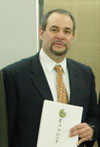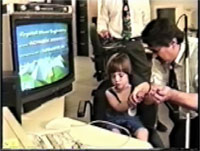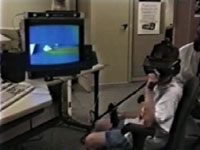Mayer Max, US Co-Chairman, Director, MindKnit Research Center, US
Biography
Mayer Max is the Director of the Moses Max MindKnit Research Center, where he brings together scientific and educational collaborations, research, and conferences on Veterans Traumatic Brain Injury, Autism, Virtual Reality, Telemedicine, Web communications and inclusion research for persons with cognitive, intellectual, behavioral and physical disabilities.
He has served in Vice President Al Gore's White House National Performance Review, helping to partner with publishers, the World Wide Web Consortium and national, international and Native American partners to build fully accessible Web Textbooks on computers. These accessible learning portals bring together children with Autism, cognitive disabilities, physical disabilities with their non-challenged peers - to build a Classroom for All, a Community for All, a Native Community for all, inclusive of all ages, challenges and abilities.
In a State, federal, community, and non-profit collaboration, Mr. Max serves as a Partner with the "New York State Governor's Veterans Traumatic Brain Injury Coalition," with his Director of the Veterans Department; Office of the Healthcare Commissioner CQCAPD; with the US Veterans Health Network for Upstate New York, the Brain Injury Association of New York State, and the MindKnit Research Center.
Serving as a National Panelist for the National Institutes of Health, National Institute of Drug Abuse (NIH/NIDA) Clinical Neural Science and Behavior Research, he provides evaluations, with other Panelists and experts, of potential research projects for: Virtual Reality, f-MRi neural substrate mapping and neural modulation and neural rehabilitation with the potential to serve: substance seeking, PTSD, burn, pain, and anxiety treatment, and with possible Traumatic Brain Injury (TBI) and Autism applications.
Mr. Max's research in Virtual Reality applications to attention and communications for children and adults with Autism, ADHD, and adults with strokes have been presented at 2 American Psychiatric Association Institutes in Washington, DC, at an American Psychiatric Association Institute in New Orleans. He has lectured on this research at "Medicine Meets Virtual Reality" Telemedicine Symposia sponsored by the University of California, San Diego, Medical School; Stanford University Medical School; DARPA; and at international conferences in Tokyo, Japan, and Montreal, Canada.
Mr. Max has led national research and Web accessible technology developments and piloted inclusion of disabilities communities in healthcare, education, and employment across the United States, and in Native American Tribal Nations, with partners in Japan JSRPD, and the Japan NRCD, a World Health Organization (WHO) Collaborating Center. Mr. Max also helps establish volunteer collaborations for national emergency preparedness and recovery networks and healthcare response networks for Hurricanes Katrina and Rita, and for future emergencies (www.volunteer.gov/gov; Keyword “Evacuation”) and worked on international disaster planning development for Web communications technology for Persons with Cognitive, Behavioral and Physical Disabilities. This will ensure that these individuals are provided full inclusion in disaster preparedness, response, and recovery with their fellow citizens. (GOOGLE: Mayer Max+Urakawa).
In the Veterans National Healthcare Volunteer Network (www.volunteer.gov/gov), Mr. Max serves as a Founding Partner, with the USA Freedom Corps, with the Governor of New York, and with the US Veterans Healthcare Administration to help build medical, community, and disaster response volunteer networks to help Veterans with Disabilities and to ensure full support in healthcare, community and work placement, and disaster response.
Mr. Max helped build and lead collaboration teams to research Virtual Reality assessment of attention and cognitive and communications abilities, and to help determine inclusion strategies in the complex multi-sensory environments found in work and education settings for children with Autism and with limitations due to challenges of sensory, communications. environmental immersion and social interaction challenges. Mr. Max helped lead collaboration teams with partners at Johns Hopkins University and the University of Louisville has been used to assess children with Autism, ages 7 through 12, including those who were unable to respond to their parents, and those children who were high functioning. These assessments were used to identify: school, community and home placement environments and interaction strategies for these children with Autism. Mr. Max was invited to present technologies and inclusion strategies at the U.S. National Autism Summit by the Secretary of Education, the Director of the National Institutes of Health, and the Director of the National Institute of Mental Health on “Transition Strategies from Childhood through Adulthood in Elementary, Secondary and Post-Secondary Education.” Mr. Max has also presented his findings at Institutes of the American Psychiatric Association in Washington, DC, and in New Orleans, Louisiana, as well as at Medicine Meets Virtual Reality Conferences hosted by the University of California, San Diego Medical School, DARPA Telemedicine, and Stanford Medical School.
In low income and disadvantaged communities in South Central Los Angeles, Boston, Albequerque and Oklahoma City, Mr. Max built an expert team of WWWC accessibility researchers and adapted a $50 million Science textbook and with the help of his partners from the World Wide Web Consortium (including Mr. Hakkinen), the Japan JSRPD (Mr. Kawamura, now at NRCD), and made it fully accessible Web textbook for 8th grade students. This was tested in low income neighborhoods and created full inclusion for all children with disabilities, alongside their school mates with no disabilities, and teachers. This also helped raise the children’s scores from 7 to 12 % in one semester in a low income neighborhood in Oklahoma City, USA, which had been the scene of a disaster affecting many families.
Mr. Max has also helped build conferences with Steven Spielberg’s SHOAH Foundation and with coast-to-coast Native American Nations to preserve vanishing Native American language and culture from extinction using models learned from the SHOAH Visual History Foundation Video Database with 50,000 plus interviews from Holocaust survivors.
Mr. Max also helped develop a fully accessible, multi-sensory Web textbook demonstration project to aid preservation efforts by the Tribal Nation of the Potawatomi language . He helped by building a tteam of collaborators wtih Don Perrott a Hannahville Potawatomi teacher and elder, including World Wide Web Consortium accessibility experts, Japanese national disabilities organizations, partners from the worldwide DAISY Consortium for accessible media and Talking Book Libraries with the elders, teachers, and community members of the Hannaville Potawatami Indian Community a Native American tribal nation in Escanaba, Michigan. Working together, this consortium built the first, multi-sensory, fully accessible Web Textbooks in the worldwide DAISY format (http://www.daisy.org), providing inclusion in language preservation and learning for persons with learning, print, and sensory focus disabilities; and for all of the elders, children and parents and teachers of the Potawatomi Tribal Nation. Mr. Max of MindKnit Research, and the Japanese JSRPD and NRCD Partners.
This collaboration of Native Nations, US researchers, Japanese disabilities organizations and World Wide Web Consortium accessibility experts was presented by Mr. Max and his collaboration partners from Native American Nations, the World Wide Web Consortium and the Japan Society for Rehabilitation for Persons with Disabilities (under Crown Prince Hitachi) at a White House "Excellence in Government Conference" as a national and international partnership role model for government and community collaboration. This was also used to help establish public policy and technology standards worldwide, working in conjunction with Tim Berners-Lee, the Founder and Director of the World Wide Web Consortium. This effort to preserve a non-diagraphical Native American language from extinction, together with building fully inclusive and fully accessible technology for persons with all cognitive, learning, print and other disabilities - helped build the case for adoption of the World Wide Web Consortium's SMIL (Synchronous Multimedia Interface Language) - for all the World Wide Web, and the citizens with and without disabilities finding inclusion through Web learning and commuications.
Organizational Affiliations, Research Projects and Guest Lectures:
New York State Traumatic Brain Injury Coalition for Returning OIF/OEF Veterans, Partner, with: Director of Veterans Affairs and Health Commissioner for Governor of New York ; Brain Injury Association of America , US Veterans Health Affairs VISN-2 Hospital Network, New York ; and MindKnit and SharkaTech Research
US Veterans National Healthcare Volunteer Community Portal, Founding Partner under: Secretary, Veterans Affairs; Governor, New York ; Secretary, Interior; and White House Freedom Corps,
MindKnit Research Center, Director: Telemedicine, Veterans Health, Autism, and Web Disabilities Communications building National and International Models for: Disabilities Healthcare, Employment, Community Inclusion, and National Emergency Preparedness for Persons with Disabilities
1999 Institute of the American Psychiatric Association, New Orleans, Louisiana, Lecturer, Researcher and Expert for Telemedicine Technology Training: Virtual Reality for Autism and ADHD Training and Assessment; "MultiMedia Session 8: Workship: Virtual Reality Therapy Updated"
National Panelist for National Institutes of Health / Clinical Neuroscience Group, Guiding Research in: Virtual Reality and f-MRI Brain Mapping and Retraining with Treatment Applications applicable to: Burn, Pain, Anxiety, Post Traumatic Stress Disorder (PTSD, Traumatic Brain Injury and Autism
Japan NRCD, World Health Organization (WHO), Japan Autism Society, Tsunami Disaster Reduction Conference, Speaker, Kobe , Japan: "Disabilities Communications Technology for Evacuation of Persons with Cognitive Disabilities such as Autism, PTSD, Schizophrenia; for the Elderly; and for Entire Communities - Using Virtual Reality, Web Disabilities Communications, and National Emergency Communications Networks"
Hurricane Katrina/Rita Healthcare Preparedness and Recovery Volunteer Medical Network, Founding Partner with: VA Medical Centers , Texas and Gulf Coast ; National PsychoSocial Rehabilitation Director, VA; Salvation Army ; and USA Freedom Corps (www.volunteer.gov/gov; Keyword "Disaster")
National Autism Summit, Speaker: Transition Planning from Pre School through Adulthood for Persons on the Autism Spectrum, Under the U.S. Secretary, Health and Human Services; U.S. Secretary of Education; Director, National Institutes of Health http://www.tvworldwide.com/events/nimh/031119/agenda.cfm 1:30pm, Session C, "Secondary/Transition" Panel
Sr. Advisor to University of Louisville , Emeritus For Telemedicine, Virtual Reality Assessment, and Autism, Kentucky Autism Training Center , KATC, School of Medicine and School of Education
GOOGLE:
Mayer Max+Veterans+MindKnit Research Center
Mayer Max+Vice President Al Gore+ICTE+International Conference on Technology in Education
Mayer Max+Veterans Healthcare+volunteer.gov (then CANCEL) (Volunteer Health Network under: Secretary of Veterans Affairs; Governor, New York;
Mayer Max+volunteer.gov (Then CANCEL) (Hurricane and Disaster Response and Recovery for Veterans Hospital Network)
Mayer Max+W3C+RDIG (World Wide Web Consortium Research and Development Interest Group; Web Employment Technology for Persons with Disabilities)
Mayer Max+National Autism Summit (National Autism Summit, Speaker on Virtual Reality Assessment, LIfelong Assessment for Transition in School and Work)
Mayer Max+Urakawa (Disaster Preparedness Technical Group. Ensuring full inclusion in Disaster Preparedness, Response and Recovery for Persons with Disabilities. Collaborating with the National Rehabilitation Center for Disabilities, and World Health Organization Collaboration Center, Tokorozawa, Japan; Developing Web Communications Technology for Persons with Autism, Cognitive and Behavioral Challenges, Physical Disabilities, Special Needs and Vulnerable Populations including the Elderly, Children and Foreign Language Speakers)
Previous page: US-Japan Vets with TBI and Autism Exchange: International Medical, Research, Speaker Bios
Next page: Dr. Reiko Fukatsu - International Co-Chairman; Director, National Rehabilitation Center for Disabilities; Senior Member National Council for the higher brain dysfunction support project, Japanese Ministry of Health, Labor, and Welfare, Tokyo, Japan



